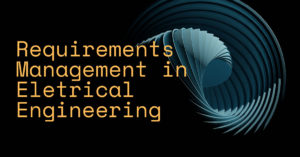
The process of identifying, documenting, and tracking the needs and expectations of project stakeholders is known as requirements management. It is an essential part of systems engineering since it guarantees that the finished product meets consumers’ expectations while complying with regulatory regulations.
Requirements management is critical for electrical and electronics projects since they contain complicated systems and have a high failure rate if requirements are not handled appropriately.
A large number of stakeholders is one of the most challenging difficulties in requirements management for electrical engineering projects.
Electrical engineering projects frequently involve stakeholders, including professional engineers, electrical system designers, and even the product’s end consumers. Each stakeholder has different needs and expectations, which may make identifying and prioritizing requirements challenging.
Furthermore, the complexity of electrical and electronic systems can make correctly capturing and documenting requirements challenging.
Valispace is an innovative requirements management platform that addresses these issues straight on. It is specially created for use in the field of electrical engineering, and it has several features that make it suitable for handling the requirements of complicated systems.
Valispace, for example, enables users to capture, manage, and validate requirements effortlessly and engage in real-time with stakeholders. It also has strong visualization and reporting features, making identifying and prioritizing requirements easy.
Electrical Engineering Requirement Types
Numerous sorts of criteria must be addressed in electrical engineering. These are examples of functional, non-functional, performance, safety, and regulatory requirements.
The exact features and capabilities a product must have to suit the demands of the users are referred to as functional requirements. An applicable requirement for an electric motor, for example, is that it revolves at a specified speed.
Non-functional requirements are the broad features a product must possess to be helpful and useable. Non-functional criteria include things like dependability, maintainability, and usability.
A set of quantitative metrics a product must achieve to be successful is performance requirements. For example, a minimum efficiency rating of 90% may be a performance criterion for an electric motor.
The procedures that must be taken to guarantee that a product is safe to use are known as safety requirements. For example, an electric motor may be required to be constructed to shut down automatically in the case of a fault.
Regulatory requirements are the rules and restrictions a product must meet to sell or be used legally. Electrical equipment, for example, must adhere to safety standards established by organizations such as the National Electric Code (NEC) in the United States.
Valispace makes managing all sorts of requirements simple by offering a platform that enables users to capture, track, and validate requirements and engage in real-time with stakeholders. It also has strong visualization and reporting features, making identifying and prioritizing requirements easy.
Requirements Analysis and Elicitation
The process of defining and acquiring project requirements is known as requirements elicitation. All stakeholders must be included in the elicitation process to ensure that all requirements are recorded and that the final product fulfils the demands of all stakeholders. This may be accomplished using various methods, including interviews, surveys, seminars, and focus groups.
The requirements must be examined once they have been elicited to identify and prioritize the most critical requirements. A range of tools and approaches, such as requirement traceability matrices, prioritization matrices, and impact analysis, can be used to accomplish this.
Valispace simplifies requirements elicitation and analysis by offering a platform that lets users capture, track, and validate requirements and engage in real time with stakeholders. It also has strong visualization and reporting features, making identifying and prioritizing requirements easy.

Verification and Validation of Requirements
The process of verifying that the requirements that have been specified are comprehensive, consistent, and traceable is known as requirements verification. This involves ensuring that the conditions are testable and align with the overall project goals.
Verifying that the requirements that have been identified fulfil the demands of the stakeholders is known as requirements validation. This involves ensuring that the criteria are practical, feasible, and meet the overall project objectives.
Valispace provides a requirement management and tracking platform, allowing for simple validation and verification. It also allows for real-time communication with stakeholders, making it simpler to guarantee that requirements are comprehensive, consistent, and traceable.
Processes and Tools for Requirements Management
Tools and software for requirements management are critical for practical requirements management. They provide a single area for storing and managing requirements and various tools for requirement capture, tracking, and validation.
Involving all stakeholders in the requirements elicitation and analysis process, ensuring that requirements are comprehensive, consistent, and traceable, and employing a centralized solution for storing and monitoring requirements are all best practices for adopting requirements management procedures.
Creating new electrical power systems, digital systems, research and development initiatives, and control systems are examples of successful requirements management in electrical engineering projects.
Learn how to properly break down requirements with our handy step-by-step guide.
Top 5 Requirements Management Tools for Electrical Engineers
Valispace:
Valispace is a software tool designed for requirements management in mechanical engineering projects. It allows teams to manage and trace requirements, BOMs and interfaces, and also to collaborate on design and testing.
Valispace is the only solution here that links requirements (and components) to technical data and engineering values. Meaning that if requirement parameters change somewhere in the project, you’ll automatically see the effect that this has on the overall system. Speak with our experts and see how Valispace fits in to your engineering workflow today
IBM Rational DOORS:
IBM Rational DOORS is a widely used requirements management tool that offers a range of features such as traceability, impact analysis, and requirements management. It is used by mechanical engineers that need to manage complex, technical projects.
IBM DOORS can be quite complex and difficult to learn, especially for users who are not familiar with requirements management tools.
Jama Software:
Jama Software also has capabilities like traceability, collaboration, and impact analysis. It is well suited for electrical engineering companies that need to manage large, complex projects.
A limitation of Jama Software for hardware engineers is that it may not be as well suited for projects with the highest degree of technical complexity.
ReqView:
ReqView offers a range of features such as traceability, collaboration, and impact analysis. It is an apt tool for electrical engineering companies that need to manage large, complex projects and need to collaborate with remote teams.
ReqView may not be as well suited for projects with a high degree of technical complexity and may not offer all the functionalities as other more complex tools.
Helix RM:
Helix RM offers traceability, collaboration, and impact analysis. It is a good option for electrical engineering companies and can integrate with other tools such as JIRA, Confluence, and more.
Helix RM may not be suitable for product development with a great deal of technical intricacy, and might not provide all the features that other more complete requirements tools do.
Requirements Management Problems and Solutions
Managing conflicting and competing requirements is one of the most challenging aspects of requirements management. This might happen when multiple stakeholders have differing project needs and expectations. A straightforward method for resolving issues and ensuring that the most critical requirements are met is essential.
Another significant problem is ensuring requirement traceability and compliance. This involves ensuring that requirements can be traced from elicitation to the final product and conform to all applicable legislation and standards.
It is also critical to address changing requirements during the project life cycle. As a project advances, requirements frequently change, and it is vital to have a straightforward procedure in place for managing and documenting these changes.
Valispace simplifies handling these difficulties by offering a platform that enables users to capture, track, and validate requirements and engage in real-time with stakeholders. It also has strong visualization and reporting features, making identifying and prioritizing requirements easy.
Summary and Prospects
Successful electrical engineering projects require excellent requirements management. It guarantees that the finished product fits the demands of the users while also meeting regulatory criteria. Formal requirements management is especially crucial for electrical and electronics projects, which contain complicated systems and have a high failure rate if requirements are not handled appropriately.
Overall, the Bureau of Labor Statistics predicts that employment of electrical and electronics engineers will grow 3 per cent from 2019 to 2029 as demand for electrical power, motor, control systems, research and development, and power systems grows, as does the need for practical requirements management.
As technology advances and the demand for new and creative electrical and electronic systems grows in the future, the necessity of competent requirements management will only expand. Electrical engineers may ensure the success of their projects and the satisfaction of all stakeholders by implementing the principles and best practices outlined in this article.

